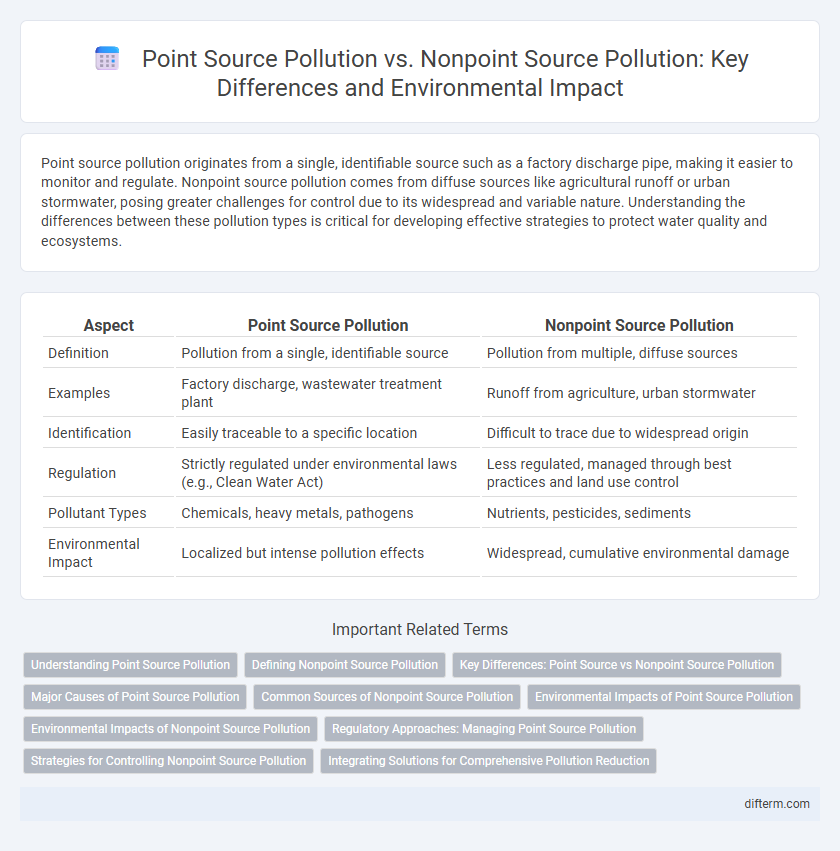Point source pollution originates from a single, identifiable source such as a factory discharge pipe, making it easier to monitor and regulate. Nonpoint source pollution comes from diffuse sources like agricultural runoff or urban stormwater, posing greater challenges for control due to its widespread and variable nature. Understanding the differences between these pollution types is critical for developing effective strategies to protect water quality and ecosystems.
Table of Comparison
| Aspect | Point Source Pollution | Nonpoint Source Pollution |
|---|---|---|
| Definition | Pollution from a single, identifiable source | Pollution from multiple, diffuse sources |
| Examples | Factory discharge, wastewater treatment plant | Runoff from agriculture, urban stormwater |
| Identification | Easily traceable to a specific location | Difficult to trace due to widespread origin |
| Regulation | Strictly regulated under environmental laws (e.g., Clean Water Act) | Less regulated, managed through best practices and land use control |
| Pollutant Types | Chemicals, heavy metals, pathogens | Nutrients, pesticides, sediments |
| Environmental Impact | Localized but intense pollution effects | Widespread, cumulative environmental damage |
Understanding Point Source Pollution
Point source pollution originates from a single, identifiable source such as a factory discharge pipe or wastewater treatment plant, allowing for easier monitoring and regulation. This type of pollution often consists of specific contaminants like heavy metals, toxic chemicals, or pathogens that enter water bodies directly. Controlling point source pollution is critical for protecting ecosystems and human health due to its measurable and traceable characteristics.
Defining Nonpoint Source Pollution
Nonpoint source pollution originates from diffuse sources such as agricultural runoff, urban stormwater, and atmospheric deposition, making it challenging to trace to a single discharge point. It contrasts with point source pollution, which involves contaminants released from identifiable locations like factories or sewage treatment plants. Nonpoint source pollution significantly contributes to water quality degradation by introducing sediments, nutrients, and chemicals into water bodies over large areas.
Key Differences: Point Source vs Nonpoint Source Pollution
Point source pollution originates from a single, identifiable source such as a factory discharge pipe, allowing for easier monitoring and regulation. Nonpoint source pollution comes from diffuse sources like agricultural runoff or urban stormwater, making it challenging to control and track. Key differences include the source distinguishability, pollutant types, and the complexity of implementing effective mitigation strategies.
Major Causes of Point Source Pollution
Major causes of point source pollution include discharge from industrial facilities, wastewater treatment plants, and oil refineries, where contaminants are released directly into water bodies through identifiable pipes or outlets. These pollutants often consist of heavy metals, toxic chemicals, and untreated sewage, leading to significant environmental degradation. Regulatory frameworks such as the Clean Water Act target these point sources to control and reduce pollution levels effectively.
Common Sources of Nonpoint Source Pollution
Common sources of nonpoint source pollution include agricultural runoff containing fertilizers and pesticides, urban stormwater carrying oil, grease, and heavy metals, and sediment from construction sites. Unlike point source pollution, which originates from identifiable discharge points, nonpoint source pollution diffuses across large areas, making it harder to control and mitigate. This widespread contamination significantly impacts water quality and aquatic ecosystems.
Environmental Impacts of Point Source Pollution
Point source pollution, originating from identifiable locations such as factories and sewage treatment plants, directly contaminates water bodies, leading to severe environmental impacts including oxygen depletion and aquatic life fatalities. This concentrated discharge introduces toxic substances like heavy metals and chemicals that disrupt ecosystems and bioaccumulate in the food chain. Effective management requires strict regulation and treatment technologies to mitigate these harmful effects and protect water quality.
Environmental Impacts of Nonpoint Source Pollution
Nonpoint source pollution, primarily from agricultural runoff, urban stormwater, and forestry activities, significantly degrades water quality by introducing excess nutrients, sediments, and toxic contaminants into aquatic ecosystems. This diffuse pollution causes eutrophication, harmful algal blooms, and habitat destruction, leading to reduced biodiversity and compromised aquatic life. Unlike point source pollution, its scattered nature complicates detection and regulation, exacerbating long-term environmental impacts.
Regulatory Approaches: Managing Point Source Pollution
Regulatory approaches to managing point source pollution focus on enforcing permit systems such as the Clean Water Act's National Pollutant Discharge Elimination System (NPDES), which requires industries and wastewater treatment plants to obtain permits limiting pollutant discharges. These regulations establish specific pollutant concentration limits, monitoring requirements, and reporting protocols to ensure compliance and protect water quality. Effective management relies on continuous enforcement, technological upgrades, and strict penalties for violations to reduce contaminants entering water bodies from identifiable sources.
Strategies for Controlling Nonpoint Source Pollution
Implementing best management practices (BMPs) such as crop rotation, contour plowing, and buffer strips effectively reduces nonpoint source pollution by minimizing runoff and soil erosion. Urban stormwater management techniques including permeable pavements, rain gardens, and green roofs capture and filter pollutants before they reach water bodies. Watershed-based planning combined with public education and policy enforcement enhances the control of diffuse pollution sources and improves overall water quality.
Integrating Solutions for Comprehensive Pollution Reduction
Point source pollution, originating from identifiable locations such as factories and wastewater treatment plants, requires targeted regulatory measures and advanced filtration technologies for effective remediation. Nonpoint source pollution stems from diffuse sources like agricultural runoff and urban stormwater, demanding landscape-level management practices including buffer zones, sustainable agriculture, and green infrastructure. Integrating these solutions enhances comprehensive pollution reduction by addressing both specific discharge points and dispersed contaminants through coordinated environmental policies and adaptive watershed management.
point source pollution vs nonpoint source pollution Infographic

 difterm.com
difterm.com